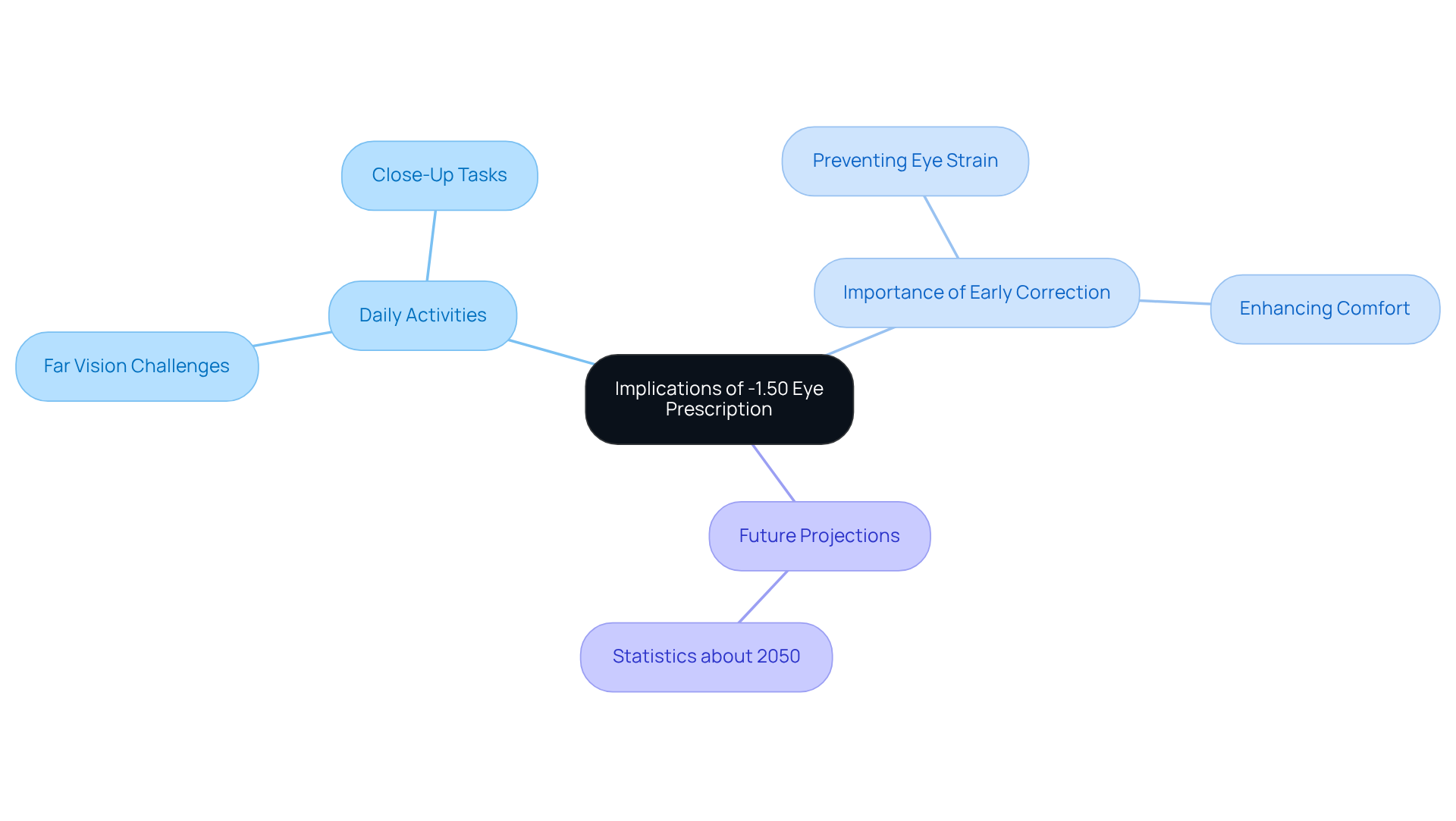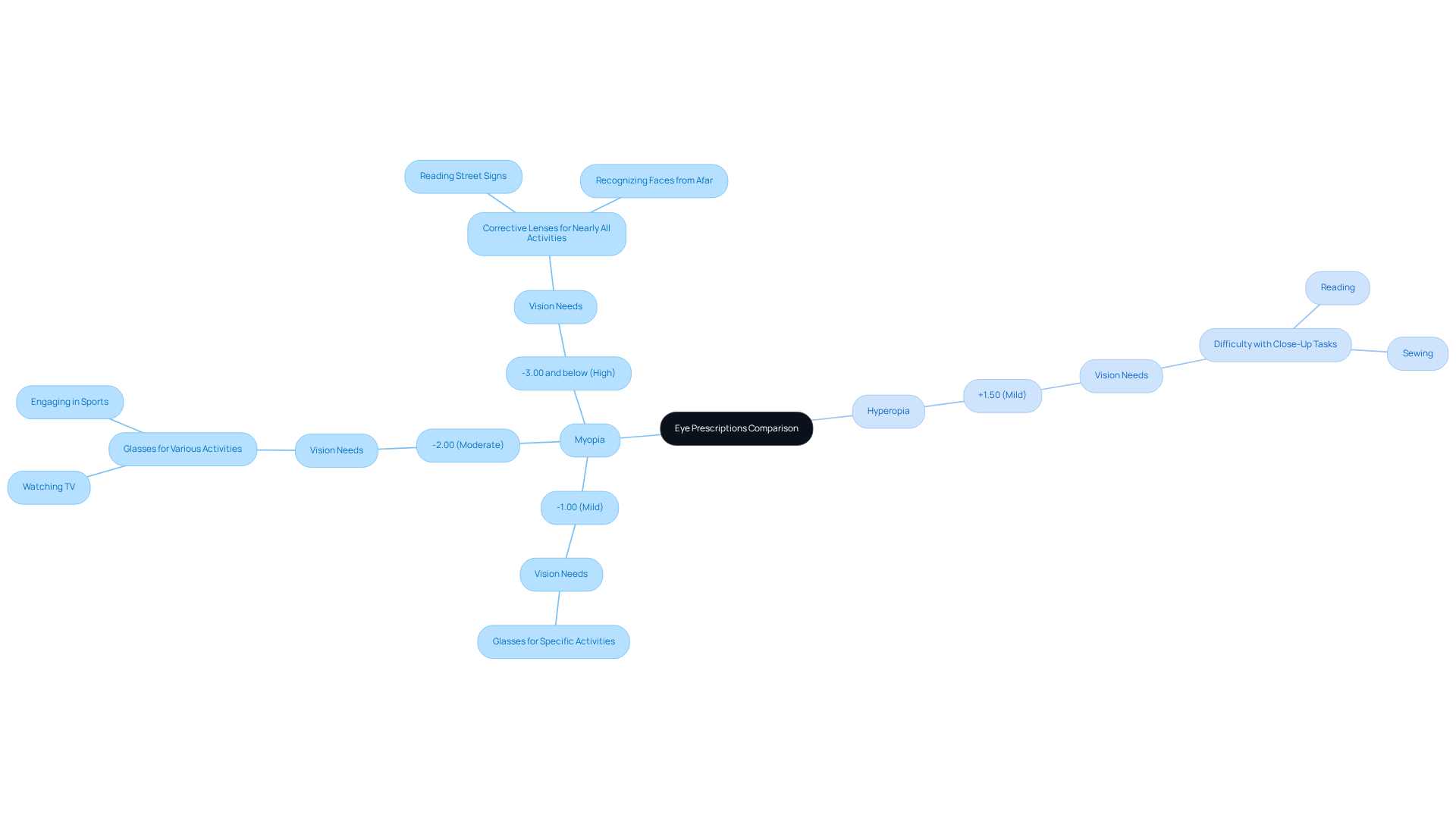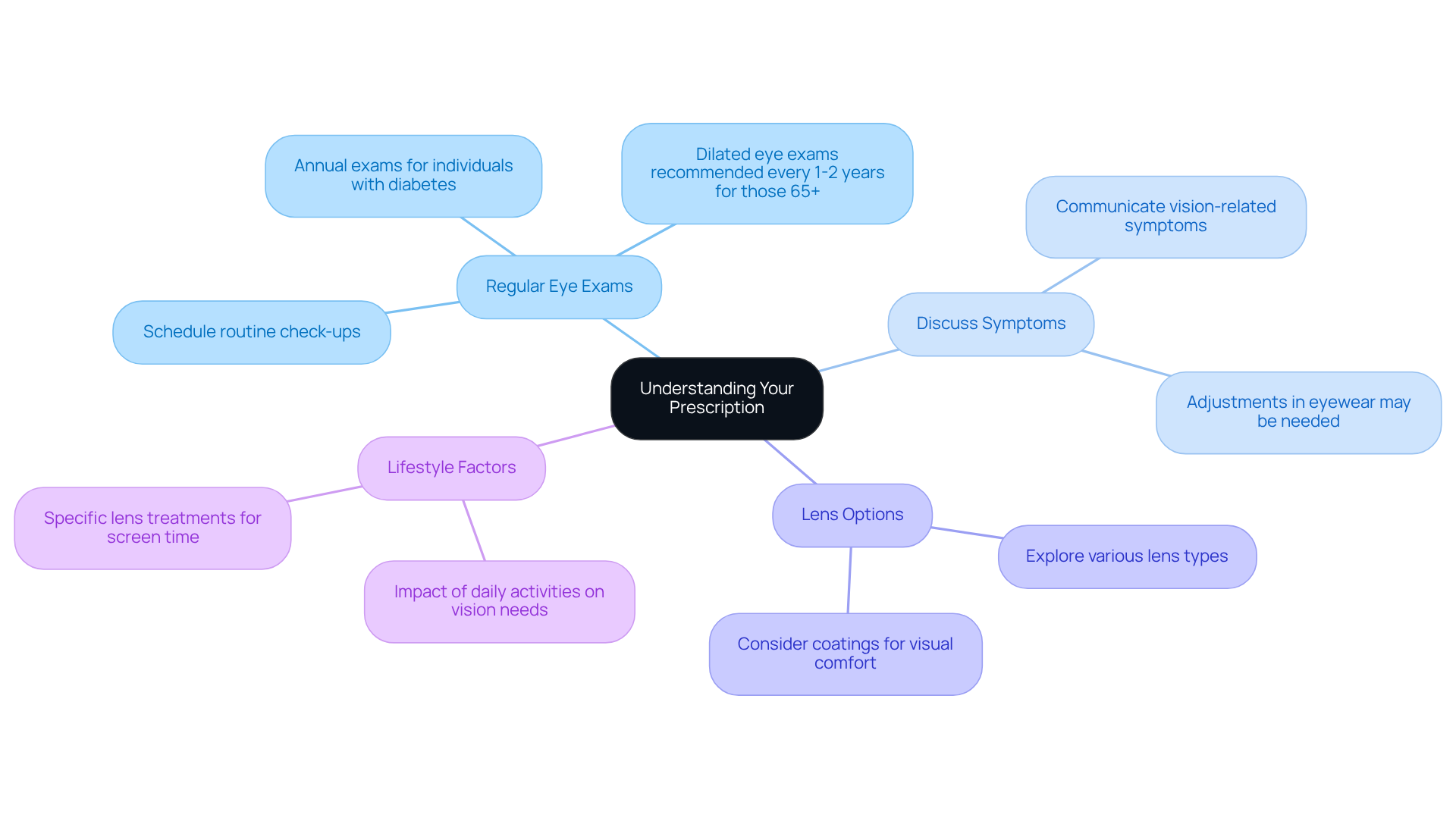Posted by: Northwest Eye in General on August 8, 2025
Overview
A -1.50 eye prescription indicates mild to moderate nearsightedness, which can make distant objects less clear while allowing for comfortable close-up tasks. We understand that this might raise some concerns for you. However, this level of nearsightedness is generally manageable in daily life.
It’s important to recognize the significance of early correction to prevent eye strain and maintain your quality of life, especially as your vision needs may evolve with age.
Remember, we are here to help you through this process.
Introduction
Navigating the world of eye prescriptions can often feel like deciphering a foreign language, especially when faced with numbers like -1.50. We understand that this level of nearsightedness, while categorized as mild to moderate, raises important questions about its impact on your daily life and overall vision quality.
Understanding how a -1.50 prescription compares to others not only sheds light on its severity but also highlights the significance of timely intervention and personalized eye care.
What does this mean for individuals living with this prescription? How can you ensure your vision remains clear and comfortable? We are here to help you through this process.
Understanding Eye Prescriptions: Basics and Terminology
Eye evaluations are typically expressed in diopters (D), which measure the lens strength needed to correct vision. We understand that navigating these terms can feel overwhelming, but knowing that a negative sign (-) indicates while a positive sign (+) signifies farsightedness (hyperopia) can help ease your concerns. Here are some common terms you might encounter:
- Sphere (SPH): This indicates the degree of nearsightedness or farsightedness you may have.
- Cylinder (CYL): This measures astigmatism, which relates to the curvature of your eye.
- Axis: The orientation of astigmatism is measured in degrees, providing further insight into your vision needs.
- Pupillary Distance (PD): This is the distance between your pupils, which is crucial for ensuring proper lens alignment.
Comprehending these terms is essential for interpreting medical orders accurately and discussing them with your eye care specialists. Remember, we are here to help you through this process, and understanding these concepts is a vital step toward achieving clearer vision.

Analyzing the 1.50 Eye Prescription: Implications for Vision
When considering a -1.50 eye prescription, how bad is that? It indicates mild to moderate nearsightedness, which can influence daily activities in multiple ways. We understand that this degree of may make it challenging to see faraway objects clearly, such as street signs or faces across a room. However, you might find that close-up tasks like reading or using a smartphone are usually manageable, despite wondering how bad a -1.50 eye prescription is.
For instance, a person may wonder how bad a -1.50 eye prescription is, as they might comfortably engage in everyday activities but may require corrective lenses for driving or watching movies, especially in low-light conditions. Early correction is crucial, as it helps prevent eye strain and enhances visual comfort.
It’s common to feel concerned about the implications of nearsightedness, especially given that statistics indicate it is becoming increasingly common. Projections suggest that by 2050, nearly 5 billion individuals will be affected by some degree of this condition. Ophthalmologists stress the significance of treating nearsightedness early to lessen its effect on quality of life. As one specialist pointed out, ‘Mild nearsightedness can result in considerable difficulties in everyday tasks if not addressed, especially as people grow older and their sight requirements evolve.’
Furthermore, the economic burden associated with unaddressed nearsightedness is significant, highlighting the necessity for timely intervention. Therefore, understanding the implications of a -1.50 eye prescription is crucial for maintaining optimal sight and overall eye wellness. We are here to help you through this process.

Comparing 1.50 Eye Prescription with Other Common Prescriptions
When discussing how bad a -1.50 eye prescription is, it becomes evident that the distinctions in vision correction needs are clear when compared to other common prescriptions.
We understand that navigating vision issues can be challenging. Individuals with a -1.00 prescription are classified as having mild myopia. They may only need glasses for specific activities, such as driving or watching films.
For those with a -2.00 prescription, this indicates moderate nearsightedness. Typically, individuals with this vision requirement find that they need glasses for various distance-related activities, like watching television or engaging in sports.
When we look at prescriptions of -3.00 and below, we see . Individuals in this category face significant challenges with distance vision and generally require corrective lenses for nearly all activities, including reading street signs or recognizing faces from afar.
In contrast, a +1.50 lens indicates mild hyperopia. Individuals with this lens may experience difficulty with close-up tasks, such as reading or sewing, while distant objects remain clear.
This comparison highlights the differing levels of eye correction needed based on lens strength. It emphasizes the significance of customized eye care solutions tailored to each person’s requirements. Remember, we are here to help you through this process and ensure your vision needs are met with compassion and understanding.

Patient Considerations: Understanding Your Prescription for Better Outcomes
Understanding your eye requirements is essential for achieving optimal visual results. We recognize that navigating eye care can feel overwhelming at times, but we are here to support you. Here are some important considerations:
- [Regular Eye Exams](https://nweyeclinic.com): It’s vital to schedule routine check-ups to monitor any changes in your vision. This allows for timely updates to your prescription, ensuring you always see your best.
- Discuss Symptoms: If you’re experiencing any vision-related symptoms, please communicate these to your eye care provider. We understand that these can be concerning, and they may indicate a need for .
- Lens Options: Take the time to explore various lens types and coatings that could enhance your visual comfort and clarity. This is especially important if you are wondering – 1.50 eye prescription how bad is that, as the right lenses can make a significant difference.
- Lifestyle Factors: Consider how your daily activities impact your vision needs. For instance, if you spend considerable time on screens, you might benefit from specific lens treatments designed to reduce eye strain.
By actively engaging with your eye care provider and gaining a deeper understanding of your prescription, you can take proactive steps toward maintaining optimal eye health. Remember, you are not alone in this journey—we are here to help you every step of the way.

Conclusion
A -1.50 eye prescription signifies mild to moderate nearsightedness, which can affect various aspects of daily life, particularly when it comes to seeing distant objects clearly. We understand that while this level of nearsightedness may not hinder close-up tasks, it is essential to recognize its potential impact on activities such as driving or watching movies, especially in low-light conditions. Understanding this prescription is crucial for making informed decisions about eye care and visual comfort.
Throughout this article, we discussed key points, including:
- The importance of comprehending eye prescription terminology
- The implications of a -1.50 prescription compared to other common prescriptions
- The necessity of early intervention to maintain optimal eye health
Regular eye exams, open communication with eye care providers, and exploring suitable lens options are vital steps in managing vision effectively.
Ultimately, being proactive about eye health and understanding individual vision needs can significantly enhance quality of life. As nearsightedness becomes increasingly prevalent, we recognize that awareness and timely intervention are essential. Embracing this knowledge empowers individuals to seek appropriate care and make informed choices for their visual well-being. Remember, we are here to help you through this process.
Frequently Asked Questions
What is an eye prescription measured in?
Eye prescriptions are typically expressed in diopters (D), which measure the lens strength needed to correct vision.
What does a negative sign (-) in an eye prescription indicate?
A negative sign (-) indicates nearsightedness.
What does a positive sign (+) in an eye prescription signify?
A positive sign (+) signifies farsightedness, also known as hyperopia.
What does the term “Sphere (SPH)” refer to in an eye prescription?
Sphere (SPH) indicates the degree of nearsightedness or farsightedness a person may have.
What is the purpose of the “Cylinder (CYL)” measurement?
Cylinder (CYL) measures astigmatism, which relates to the curvature of the eye.
What does the “Axis” measurement represent?
The Axis indicates the orientation of astigmatism, measured in degrees, providing further insight into vision needs.
What is “Pupillary Distance (PD)” and why is it important?
Pupillary Distance (PD) is the distance between the pupils, crucial for ensuring proper lens alignment.
Why is understanding eye prescription terminology important?
Understanding these terms is essential for accurately interpreting medical orders and discussing them with eye care specialists.






